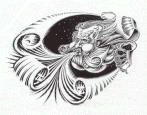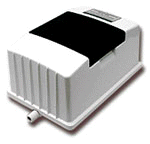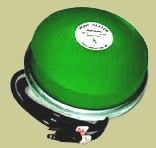|
 |
|

|
In Northern states where the water in a pond will freeze
over, special care needs to be taken to help fish such as koi, comets,
fantails and others to survive. These fish are all hardy for most
northern areas but conditions in a small backyard pond put extra
stresses on them.
 Fish are cold blooded creatures. When the ambient temperature of
the pond water drops below a certain minimum, they become inactive and
drop to the bottom of the pond. Once the water is below 50 degrees F,
stop feeding the fish even if they continue to come to the surface and
beg. At lower temperatures, the digestive system of the fish does not
work fully and partially digested food may cause a blockage. This
could result in death of the fish. Fish are cold blooded creatures. When the ambient temperature of
the pond water drops below a certain minimum, they become inactive and
drop to the bottom of the pond. Once the water is below 50 degrees F,
stop feeding the fish even if they continue to come to the surface and
beg. At lower temperatures, the digestive system of the fish does not
work fully and partially digested food may cause a blockage. This
could result in death of the fish.
The key reason that fish die in the winter is that the
"gunk" on the bottom of the pond continues to decompose
slowly in the cold water. In the process, it releases gases such as
ammonia and others. If the surface of the water is not frozen, this
gas simply escapes into the atmosphere. If the pond surface is frozen
solid, the gas is trapped and may build to lethal levels resulting in
the death of the fish.
Most people either try to keep the fish in the pond but a few take
the extra step of creating a pond indoors and bringing the fish inside
for the winter.
|
 In the Pond In the Pond
First, to keep the fish in the pond, it needs to be at least 18
inches deep. Two to three feet deep provides and extra buffer. If
you live in an area where natural lakes and ponds form a foot or
more of ice each winter, you really need to use a deeper pond if
you want to keep them outside.
If the pond depth is adequate to prevent freezing solid, the
next concern is the build up of toxic gases. Fish droppings and
plant materials such as leaves will produce toxic gases such as
ammonia when they decompose.
When the surface of the pond is open, these gases merely disperse
into the air. But, if the pond is covered with ice, they are
trapped and may build to toxic levels.
 To prevent such buildup, many people use an air bubbler to keep
part of the surface of the pond free of ice. In severe weather,
this may need to be supplemented with a stock tank heater. Avoid
using the tank heater all winter unless you have stock in the
local utility company.
To prevent such buildup, many people use an air bubbler to keep
part of the surface of the pond free of ice. In severe weather,
this may need to be supplemented with a stock tank heater. Avoid
using the tank heater all winter unless you have stock in the
local utility company.
Keeping the pond clean and well filtered will reduce the
potential amount of toxic gases produced. If the pond is clean
going into the winter and you live in an area where the pond is
only frozen for short periods, the fish may survive without any
extra help.
 Remember that fish are cold-blooded creatures. They get their
body heat from the temperature of the water. Their digestive
systems do not begin to fully function until the water temperature
is above 50 degrees F. Although they may be swimming around the
pond in colder temperatures, avoid the temptation to feed them
until the pond reaches 50 degrees. If their body temperature is
too cold when they are fed, you run the risk of having their
digestive tract clogged up resulting in their death. Remember that fish are cold-blooded creatures. They get their
body heat from the temperature of the water. Their digestive
systems do not begin to fully function until the water temperature
is above 50 degrees F. Although they may be swimming around the
pond in colder temperatures, avoid the temptation to feed them
until the pond reaches 50 degrees. If their body temperature is
too cold when they are fed, you run the risk of having their
digestive tract clogged up resulting in their death.
|
 In the House In the House
-
If you have especially valuable fish or if winters in your
areas are extremely severe, you can always bring your fish indoors. A
large livestock watering tank or a structure made of wooden
frame with pond liner may be used to hold the fish in the
basement.
-
You will need to have some type of water circulation system
and some filtration. Depending on the temperature of your
basement, you should probably cut back on the amount of feed
which will help cut back on other problems.
-
In the spring when your outdoor pond is above 50 degrees, you
can reintroduce the fish. Whether you transport them in a
plastic container or bag, allow the container to float in the
water for several hours to slowly equalize the temperature. This
will help to avoid shock to the fish during rapid temperature
changes.
|
|



